Climate Vulnerability and Adaptation Challenges in Szekszárd Wine Region, Hungary
Abstract
1. Introduction
2. Materials and Methods
3. Results
4. Discussion
5. Conclusions
Funding
Institutional Review Board Statement
Informed Consent Statement
Acknowledgments
Conflicts of Interest
References
- Agovino, M.; Casaccia, M.; Ciommi, M.; Ferrara, M.; Marchesano, K. Agriculture, climate change and sustainability: The case of EU-28. Ecol. Indic. 2019, 105, 525–543. [Google Scholar] [CrossRef]
- Burke, M.; Emerick, K. Adaptation to climate change: Evidence from US agriculture. Am. Econ. J. Econ. Policy 2016, 8, 106–140. [Google Scholar] [CrossRef]
- Fraga, H. Viticulture and winemaking under climate change. Agronomy 2019, 9, 783. [Google Scholar] [CrossRef]
- Cabré, F.; Nuñez, M. Impacts of climate change on viticulture in Argentina. Reg. Environ. Chang. 2020, 20, 12. [Google Scholar] [CrossRef]
- Van Leeuwen, C.; Destrac-Irvine, A.; Dubernet, M.; Duchêne, E.; Gowdy, M.; Marguerit, E.; Pieri, P.; Parker, A.; De Rességuier, L.; Ollat, N. An update on the impact of climate change in viticulture and potential adaptations. Agronomy 2019, 9, 514. [Google Scholar] [CrossRef]
- Jones, G.V.; Webb, L.B. Climate Change, Viticulture, and Wine: Challenges and Opportunities. J. Wine Res. 2010, 21, 103–106. [Google Scholar] [CrossRef]
- Scozzafava, G.; Contini, C.; Costanigro, M.; Casini, L.; Anderson, K. Consumer Response to Quality Differentiation Strategies in Wine PDOs. Agric. Agric. Sci. Procedia 2017, 6, 107–114. [Google Scholar] [CrossRef]
- Anderson, K. How might climate changes and preference changes affect the competitiveness of the world׳s wine regions? Wine Econ. Policy 2017, 6, 23–27. [Google Scholar] [CrossRef]
- Coste, A.; Sousa, P.; Malfeito-Ferreira, M. Wine tasting based on emotional responses: An expedite approach to distinguish between warm and cool climate dry red wine styles. Food Res. Int. 2018, 106, 11–21. [Google Scholar] [CrossRef]
- Prata-Sena, M.; Castro-Carvalho, B.M.; Nunes, S.; Amaral, B.; Silva, P. The terroir of Port wine: Two hundred and sixty years of history. Food Chem. 2018, 257, 388–398. [Google Scholar] [CrossRef]
- Renaud-Gentié, C.; Dieu, V.; Thiollet-Scholtus, M.; Mérot, A. Addressing organic viticulture environmental burdens by better understanding interannual impact variations. Int. J. Life Cycle Assess. 2020, 25, 1307–1322. [Google Scholar] [CrossRef]
- Marx, W.; Haunschild, R.; Bornmann, L. Climate change and viticulture-A quantitative analysis of a highly dynamic research field. Vitis-J. Grapevine Res. 2017, 56, 35–43. [Google Scholar] [CrossRef]
- Ponti, L.; Gutierrez, A.; Boggia, A.; Neteler, M. Analysis of Grape Production in the Face of Climate Change. Climate 2018, 6, 20. [Google Scholar] [CrossRef]
- Bernardo, S.; Dinis, L.T.; Machado, N.; Moutinho-Pereira, J. Grapevine abiotic stress assessment and search for sustainable adaptation strategies in Mediterranean-like climates. A review. Agron. Sustain. Dev. 2018, 38, 1–20. [Google Scholar] [CrossRef]
- Pomarici, E.; Vecchio, R. Will sustainability shape the future wine market? Wine Econ. Policy 2019, 8, 1–4. [Google Scholar] [CrossRef]
- Schultz, H.R. Global Climate Change, Sustainability, and Some Challenges for Grape and Wine Production. J. Wine Econ. 2016, 11, 181–200. [Google Scholar] [CrossRef]
- Leolini, L.; Moriondo, M.; Fila, G.; Costafreda-Aumedes, S.; Ferrise, R.; Bindi, M. Late spring frost impacts on future grapevine distribution in Europe. F. Crop. Res. 2018, 222, 197–208. [Google Scholar] [CrossRef]
- Cardell, M.F.; Amengual, A.; Romero, R. Future effects of climate change on the suitability of wine grape production across Europe. Reg. Environ. Chang. 2019, 19, 2299–2310. [Google Scholar] [CrossRef]
- Bucur, G.M.; Cojocaru, G.A.; Antoce, A.O. The climate change influences and trends on the grapevine growing in Southern Romania: A long-term study. BIO Web Conf. 2019, 15, 01008. [Google Scholar] [CrossRef]
- Santos, J.A.; Fraga, H.; Malheiro, A.C.; Moutinho-Pereira, J.; Dinis, L.T.; Correia, C.; Moriondo, M.; Leolini, L.; Dibari, C.; Costafreda-Aumedes, S.; et al. A review of the potential climate change impacts and adaptation options for European viticulture. Appl. Sci. 2020, 10, 3092. [Google Scholar] [CrossRef]
- Jones, N.K. An investigation of trends in viticultural climatic indices in Southern Quebec, a cool climate wine region. J. Wine Res. 2018, 29, 120–129. [Google Scholar] [CrossRef]
- Moscovici, D.; Gottlieb, P.D. Finding a state of sustainable wine: Implications for sustainable viticulture and oenology in New Jersey, USA. Int. J. Sustain. Agric. Manag. Inform. 2017, 3, 196–214. [Google Scholar] [CrossRef]
- Solman, S.; Cabré, M.F.; González, M.H.; Núñez, M.N. Bioclimatic zoning of Argentinian Malbec grape productivity regions by means of a unique combined index. Clim. Res. 2018, 74, 185–199. [Google Scholar] [CrossRef]
- Coelho, A.; Montaigne, E. The Chilean Wine Cluster. In The Palgrave Handbook of Wine Industry Economics; Alonso Ugaglia, A., Cardebat, J.-M., Corsi, A., Eds.; Springer International Publishing: Cham, Switzerland, 2019; pp. 487–506. ISBN 978-3-319-98633-3. [Google Scholar]
- Vink, N. The South African Wine Industry. In The Palgrave Handbook of Wine Industry Economics; Alonso Ugaglia, A., Cardebat, J.-M., Corsi, A., Eds.; Springer International Publishing: Cham, Switzerland, 2019; pp. 201–223. ISBN 978-3-319-98633-3. [Google Scholar]
- Naude, M.J. Impact of Climate Change and Extreme Weather Conditions on wine growing within the Stellenbosch region. J. Contemp. Manag. 2019, 16, 111–134. [Google Scholar] [CrossRef]
- Soltanzadeh, I.; Bonnardot, V.; Sturman, A.; Quénol, H.; Zawar-Reza, P. Assessment of the ARW-WRF model over complex terrain: The case of the Stellenbosch Wine of Origin district of South Africa. Theor. Appl. Climatol. 2017, 129, 1407–1427. [Google Scholar] [CrossRef]
- Jarvis, C.; Barlow, E.; Darbyshire, R.; Eckard, R.; Goodwin, I. Relationship between viticultural climatic indices and grape maturity in Australia. Int. J. Biometeorol. 2017, 61, 1849–1862. [Google Scholar] [CrossRef]
- Bardsley, D.K.; Palazzo, E.; Pütz, M. Regional path dependence and climate change adaptation: A case study from the McLaren Vale, South Australia. J. Rural Stud. 2018, 63, 24–33. [Google Scholar] [CrossRef]
- Phogat, V.; Cox, J.W.; Šimůnek, J. Identifying the future water and salinity risks to irrigated viticulture in the Murray-Darling Basin, South Australia. Agric. Water Manag. 2018, 201, 107–117. [Google Scholar] [CrossRef]
- Mosedale, J.R.; Abernethy, K.E.; Smart, R.E.; Wilson, R.J.; Maclean, I.M.D. Climate change impacts and adaptive strategies: Lessons from the grapevine. Glob. Chang. Biol. 2016, 22, 3814–3828. [Google Scholar] [CrossRef]
- Bonfante, A.; Monaco, E.; Langella, G.; Mercogliano, P.; Bucchignani, E.; Manna, P.; Terribile, F. A dynamic viticultural zoning to explore the resilience of terroir concept under climate change. Sci. Total Environ. 2018, 624, 294–308. [Google Scholar] [CrossRef]
- Hannah, L.; Roehrdanz, P.R.; Ikegami, M.; Shepard, A.V.; Shaw, M.R.; Tabor, G.; Zhi, L.; Marquet, P.A.; Hijmans, R.J. Climate change, wine, and conservation. Proc. Natl. Acad. Sci. USA 2013, 110, 6907–6912. [Google Scholar] [CrossRef]
- Nesbitt, A.; Dorling, S.; Lovett, A. A suitability model for viticulture in England and Wales: Opportunities for investment, sector growth and increased climate resilience. J. Land Use Sci. 2018, 13, 414–438. [Google Scholar] [CrossRef]
- Maciejczak, M.; Mikiciuk, J. Climate change impact on viticulture in Poland. Int. J. Clim. Chang. Strateg. Manag. 2019, 11, 254–264. [Google Scholar] [CrossRef]
- Neethling, E.; Barbeau, G.; Coulon-Leroy, C.; Quénol, H. Spatial complexity and temporal dynamics in viticulture: A review of climate-driven scales. Agric. For. Meteorol. 2019, 276–277, 107618. [Google Scholar] [CrossRef]
- Nowlin, J.W.; Bunch, R.L.; Jones, G.V. Viticultural site selection: Testing the effectiveness of North Carolina’s commercial vineyards. Appl. Geogr. 2019, 106, 22–39. [Google Scholar] [CrossRef]
- Terribile, F.; Bonfante, A.; D’Antonio, A.; De Mascellis, R.; De Michele, C.; Langella, G.; Manna, P.; Mileti, F.A.; Vingiani, S.; Basile, A. A geospatial decision support system for supporting quality viticulture at the landscape scale. Comput. Electron. Agric. 2017, 140, 88–102. [Google Scholar] [CrossRef]
- Fraga, H.; García de Cortázar Atauri, I.; Santos, J.A. Viticultural irrigation demands under climate change scenarios in Portugal. Agric. Water Manag. 2018, 196, 66–74. [Google Scholar] [CrossRef]
- Tóth, J.P.; Végvári, Z. Future of winegrape growing regions in Europe. Aust. J. Grape Wine Res. 2016, 22, 64–72. [Google Scholar] [CrossRef]
- Dunn, M.; Rounsevell, M.D.A.; Boberg, F.; Clarke, E.; Christensen, J.; Madsen, M.S. The future potential for wine production in Scotland under high-end climate change. Reg. Environ. Chang. 2017, 1–10. [Google Scholar] [CrossRef]
- Lereboullet, A.L.; Beltrando, G.; Bardsley, D.K. Socio-ecological adaptation to climate change: A comparative case study from the Mediterranean wine industry in France and Australia. Agric. Ecosyst. Environ. 2013, 164, 273–285. [Google Scholar] [CrossRef]
- Dunn, M.R.; Lindesay, J.A.; Howden, M. Spatial and temporal scales of future climate information for climate change adaptation in viticulture: A case study of User needs in the Australian winegrape sector. Aust. J. Grape Wine Res. 2015, 21, 226–239. [Google Scholar] [CrossRef]
- Costa, J.M.; Vaz, M.; Escalona, J.; Egipto, R.; Lopes, C.; Medrano, H.; Chaves, M.M. Modern viticulture in southern Europe: Vulnerabilities and strategies for adaptation to water scarcity. Agric. Water Manag. 2016, 164, 5–18. [Google Scholar] [CrossRef]
- Li, Y.; Bardají, I. Adapting the wine industry in China to climate change: Challenges and opportunities. OENO One 2017, 51, 71–89. [Google Scholar] [CrossRef]
- Serpa, D.; Nunes, J.P.; Keizer, J.J.; Abrantes, N. Impacts of climate and land use changes on the water quality of a small Mediterranean catchment with intensive viticulture. Environ. Pollut. 2017, 224, 454–465. [Google Scholar] [CrossRef]
- de la Fuente, M.; Linares, R.; Lissarrague, J.R. Adapting to climate change: The role of canopy management and water use efficiency in vineyards. Wine Vitic. J. 2016, 31, 43–46. [Google Scholar]
- Brunori, E.; Farina, R.; Biasi, R. Agriculture, Ecosystems and Environment Sustainable viticulture: The carbon-sink function of the vineyard. Agric. Ecosyst. Environ. 2016, 223, 10–21. [Google Scholar] [CrossRef]
- Ollat, N.; van Leeuwen, C. The challenging issue of climate change for sustainable grape and wine production. OENO One 2017, 51, 2–4. [Google Scholar] [CrossRef]
- Sabir, A. Sustainable Viticulture Practices on the Face of Climate Change. Agric. Res. Technol. Open Access J. 2018, 17. [Google Scholar] [CrossRef]
- Santiago-Brown, I.; Metcalfe, A.; Jerram, C.; Collins, C. Sustainability Assessment in Wine-Grape Growing in the New World: Economic, Environmental, and Social Indicators for Agricultural Businesses. Sustainability 2015, 7, 8178–8204. [Google Scholar] [CrossRef]
- Unruh, G.C. Understanding carbon lock-in. Energy Policy 2000, 28, 817–830. [Google Scholar] [CrossRef]
- Seto, K.C.; Davis, S.J.; Mitchell, R.B.; Stokes, E.C.; Unruh, G.; Ürge-Vorsatz, D. Carbon Lock-In: Types, Causes, and Policy Implications. Annu. Rev. Environ. Resour. 2016, 41, 425–452. [Google Scholar] [CrossRef]
- Kosik, I. Climate Signals in Wine Quality Time-Series of North-East Hungary. Air Water Components Environ. 2017, 9, 219–226. [Google Scholar] [CrossRef]
- Kovács, E.; Puskás, J.; Pozsgai, A. Positive Effects of Climate Change on the Field of Sopron Wine-Growing Region in Hungary. In Proceedings of the Perspectives on Atmospheric Sciences; Karacostas, T., Bais, A., Nastos, P.T., Eds.; Springer International Publishing: Cham, Swizterland, 2017; pp. 607–613. [Google Scholar]
- Kovács, E.; Puskás, J.; Pozsgai, A.; Kozma, K. Shift in the annual growth cycle of grapevines (Vitis vinifera L.) in West Hungary. Appl. Ecol. Environ. Res. 2018, 16, 2029–2042. [Google Scholar] [CrossRef]
- Mesterházy, I.; Mészáros, R.; Pongrácz, R.; Bodor, P.; Ladányi, M. The analysis of climatic indicators using different growing season calculation methods—An application to grapevine grown in Hungary. Idojaras 2018, 122, 217–235. [Google Scholar] [CrossRef]
- Szenteleki, K.; Horváth, L.; Ladányi, M. Climate Risk and Climate Analogies in Hungarian Viticulture. Int. Conf. Futur. Environ. Energy 2012, 28, 250–254. [Google Scholar]
- Magrini, M.; Anton, M.; Chardigny, J.; Duc, G.; Duru, M.; Jeuffroy, M.; Meynard, J.; Micard, V. Pulses for Sustainability: Breaking Agriculture and Food Sectors Out of. Front. Sustain. Food Syst. 2018, 2, 1–17. [Google Scholar] [CrossRef]
- Nair, S.; Howlett, M. From robustness to resilience: Avoiding policy traps in the long term. Sustain. Sci. 2016, 11, 909–917. [Google Scholar] [CrossRef]
- Li, L.; Cao, R.; Wei, K.; Wang, W.; Chen, L. Adapting climate change challenge: A new vulnerability assessment framework from the global perspective. J. Clean. Prod. 2019, 217, 216–224. [Google Scholar] [CrossRef]
- Apreda, C.; D’Ambrosio, V.; Di Martino, F. A climate vulnerability and impact assessment model for complex urban systems. Environ. Sci. Policy 2019, 93, 11–26. [Google Scholar] [CrossRef]
- Hasan, M.K.; Kumar, L. Comparison between meteorological data and farmer perceptions of climate change and vulnerability in relation to adaptation. J. Environ. Manag. 2019, 237, 54–62. [Google Scholar] [CrossRef]
- Kim, B.T.; Brown, C.L.; Kim, D.H. Assessment on the vulnerability of Korean aquaculture to climate change. Mar. Policy 2019, 99, 111–122. [Google Scholar] [CrossRef]
- Aubin, I.; Boisvert-Marsh, L.; Kebli, H.; McKenney, D.; Pedlar, J.; Lawrence, K.; Hogg, E.H.; Boulanger, Y.; Gauthier, S.; Ste-Marie, C. Tree vulnerability to climate change: Improving exposure-based assessments using traits as indicators of sensitivity: Improving. Ecosphere 2018, 9, e02108. [Google Scholar] [CrossRef]
- Birkmann, J.; Welle, T. Assessing the risk of loss and damage: Exposure, vulnerability and risk to climate-related hazards for different country classifications. Int. J. Glob. Warm. 2015, 8, 191–212. [Google Scholar] [CrossRef]
- Sharma, J.; Ravindranath, N.H. Applying IPCC 2014 framework for hazard-specific vulnerability assessment under climate change. Environ. Res. Commun. 2019, 1, 051004. [Google Scholar] [CrossRef]
- Zhang, Q.; Zhao, X.; Tang, H. Vulnerability of communities to climate change: Application of the livelihood vulnerability index to an environmentally sensitive region of China. Clim. Dev. 2019, 11, 525–542. [Google Scholar] [CrossRef]
- Blanka, V.; Mezosi, G.; Meyer, B. Projected changes in the drought hazard in Hungary due to climate change. Idojaras 2013, 117, 219–237. [Google Scholar]
- Fiala, K.; Blanka, V.; Ladányi, Z.; Szilassi, P.; Benyhe, B.; Dolinaj, D.; Pálfai, I. Drought Severity and its Effect on Agricultural Production in the Hungarian-Serbian Cross-Border Area. J. Environ. Geogr. 2015, 7, 43–51. [Google Scholar] [CrossRef]
- Dickinson, R.E.; Errico, R.M.; Giorgi, F.; Bates, G.T. A regional climate model for the western United States. Clim. Chang. 1989, 15, 383–422. [Google Scholar] [CrossRef]
- Giorgi, F.; Coppola, E.; Solmon, F.; Mariotti, L.; Sylla, M.B.; Bi, X.; Elguindi, N.; Diro, G.T.; Nair, V.; Giuliani, G.; et al. RegCM4: Model description and preliminary tests over multiple CORDEX domains. Clim. Res. 2012, 52, 7–29. [Google Scholar] [CrossRef]
- Farda, A.; Déué, M.; Somot, S.; Horányi, A.; Spiridonov, V.; Tóth, H. Model ALADIN as regional climate model for Central and Eastern Europe. Stud. Geophys. Geod. 2010, 54, 313–332. [Google Scholar] [CrossRef]
- Csima, G.; Horanyi, A. Validation of the ALADIN-Climate regional climate model at the Hungarian Meteorological Service. Időjárás 2008, 112, 155–177. [Google Scholar]
- Zsebeházi, G.; Szépszó, G. Modeling the urban climate of Budapest using the SURFEX land surface model driven by the ALADIN-climate regional climate model results. Idojaras 2020, 124, 191–207. [Google Scholar] [CrossRef]
- Mezősi, G.; Bata, T.; Meyer, B.C.; Blanka, V.; Ladányi, Z. Climate Change Impacts on Environmental Hazards on the Great Hungarian Plain, Carpathian Basin. Int. J. Disaster Risk Sci. 2014, 5, 136–146. [Google Scholar] [CrossRef][Green Version]
- Foden, W.B.; Young, B.E.; Akçakaya, H.R.; Garcia, R.A.; Hoffmann, A.A.; Stein, B.A.; Thomas, C.D.; Wheatley, C.J.; Bickford, D.; Carr, J.A.; et al. Climate change vulnerability assessment of species. Wiley Interdiscip. Rev. Clim. Chang. 2019, 10, 1–36. [Google Scholar] [CrossRef]
- Thorne, J.H.; Choe, H.; Stine, P.A.; Chambers, J.C.; Holguin, A.; Kerr, A.C.; Schwartz, M.W. Climate change vulnerability assessment of forests in the Southwest USA. Clim. Chang. 2018, 148, 387–402. [Google Scholar] [CrossRef]
- Berardy, A.; Chester, M.V. Climate change vulnerability in the food, energy, and water nexus: Concerns for agricultural production in Arizona and its urban export supply. Environ. Res. Lett. 2017, 12, 035004. [Google Scholar] [CrossRef]
- Boswell, M.R.; Greve, A.I.; Seale, T.L. Climate Change Vulnerability Assessment. In Climate Action Planning: A Guide to Creating Low-Carbon, Resilient Communities; Island Press/Center for Resource Economics: Washington, DC, USA, 2019; pp. 172–191. ISBN 978-1-61091-964-7. [Google Scholar]
- Parker, L.; Bourgoin, C.; Martinez-Valle, A.; Läderach, P. Vulnerability of the agricultural sector to climate change: The development of a pan-tropical Climate Risk Vulnerability Assessment to inform sub-national decision making. PLoS ONE 2019, 14, 1–25. [Google Scholar] [CrossRef]
- Blanco-Ward, D.; García Queijeiro, J.M.; Jones, G.V. Spatial climate variability and viticulture in the Miño River Valley of Spain. Vitis-J. Grapevine Res. 2007, 46, 63–70. [Google Scholar]
- Jones, G.V.; Davis, R.E. Climate Influences on Grapevine Phenology, Grape Composition, and Wine Production and Quality for Bordeaux, France. Am. J. Enol. Vitic. 2000, 51, 249–261. [Google Scholar]
- Zsófi, Z.S.; Tóth, E.; Rusjan, D.; Bálo, B. Terroir aspects of grape quality in a cool climate wine region: Relationship between water deficit, vegetative growth and berry sugar concentration. Sci. Hortic. (Amsterdam) 2011, 127, 494–499. [Google Scholar] [CrossRef]
- Shellie, K.C. Interactive Effects of Deficit Irrigation and Berry Exposure Aspect on Merlot and Cabernet Sauvignon in an Arid Climate. Am. J. Enol. Vitic. 2011, 62, 462–470. [Google Scholar] [CrossRef]
- Hajdu, E. Magyar Szőlőfajták (Hungarian Grape Varieties)-in Hungarian; Mezőgazda Kiadó: Budapest, Hungary, 2013; ISBN 978-963-286-670-3. [Google Scholar]
- Ortega-Farias, S.; Riveros-Burgos, C. Modeling phenology of four grapevine cultivars (Vitis vinifera L.) in Mediterranean climate conditions. Sci. Hortic. (Amsterdam) 2019, 250, 38–44. [Google Scholar] [CrossRef]
- Bai, X.; Dawson, R.J.; Ürge-Vorsatz, D.; Delgado, G.C.; Salisu Barau, A.; Dhakal, S.; Dodman, D.; Leonardsen, L.; Masson-Delmotte, V.; Roberts, D.C.; et al. Six research priorities for cities and climate change. Nature 2018, 555, 23–25. [Google Scholar] [CrossRef] [PubMed]
- Liang, Z.; Wu, S.; Wang, Y.; Wei, F.; Huang, J.; Shen, J.; Li, S. The relationship between urban form and heat island intensity along the urban development gradients. Sci. Total Environ. 2019, 708, 135011. [Google Scholar] [CrossRef] [PubMed]
- Bernetti, I.; Menghini, S.; Marinelli, N.; Sacchelli, S.; Sottini, V.A. Assessment of climate change impact on viticulture: Economic evaluations and adaptation strategies analysis for the Tuscan wine sector. Wine Econ. Policy 2012, 1, 73–86. [Google Scholar] [CrossRef][Green Version]
- Nicholas, K.A.; Durham, W.H. Farm-scale adaptation and vulnerability to environmental stresses: Insights from winegrowing in Northern California. Glob. Environ. Chang. 2012, 22, 483–494. [Google Scholar] [CrossRef]
- Mozell, M.R.; Thachn, L. The impact of climate change on the global wine industry: Challenges & solutions. Wine Econ. Policy 2014, 3, 81–89. [Google Scholar] [CrossRef]
- Fleming, A.; Park, S.E.; Marshall, N.A. Enhancing adaptation outcomes for transformation: Climate change in the Australian wine industry. J. Wine Res. 2015, 26, 99–114. [Google Scholar] [CrossRef]
- Niles, M.T.; Brown, M.; Dynes, R. Farmer’s intended and actual adoption of climate change mitigation and adaptation strategies. Clim. Chang. 2016, 135, 277–295. [Google Scholar] [CrossRef]
- Sacchelli, S.; Fabbrizzi, S.; Menghini, S. Climate change effects and adaptation strategies in the wine sector: A quantitative literature review. Wine Econ. Policy 2016, 5, 114–126. [Google Scholar] [CrossRef]
- Vaz, M.; Coelho, R.; Rato, A.; Samara-Lima, R.; Silva, L.L.; Campostrini, E.; Mota, J.B. Adaptive strategies of two Mediterranean grapevines varieties (Aragonez syn. Tempranillo and Trincadeira) face drought: Physiological and structural responses. Theor. Exp. Plant Physiol. 2016, 28, 205–220. [Google Scholar] [CrossRef]
- Zhu, X.; Moriondo, M.; van Ierland, E.C.; Trombi, G.; Bindi, M. A model-based assessment of adaptation options for Chianti wine production in Tuscany (Italy) under climate change. Reg. Environ. Chang. 2016, 16, 85–96. [Google Scholar] [CrossRef]
- Neethling, E.; Petitjean, T.; Quénol, H.; Barbeau, G. Assessing local climate vulnerability and winegrowers’ adaptive processes in the context of climate change. Mitig. Adapt. Strateg. Glob. Chang. 2017, 22, 777–803. [Google Scholar] [CrossRef]
- Merloni, E.; Camanzi, L.; Mulazzani, L.; Malorgio, G. Adaptive capacity to climate change in the wine industry: A Bayesian Network approach. Wine Econ. Policy 2018, 7, 165–177. [Google Scholar] [CrossRef]
- Santillán, D.; Garrote, L.; Iglesias, A.; Sotes, V. Climate change risks and adaptation: New indicators for Mediterranean viticulture. Mitig. Adapt. Strateg. Glob. Chang. 2019, 25, 881–899. [Google Scholar] [CrossRef]
- Bartholy, J.; Pongracz, R.; Torma, C.; Pieczka, I.; Kardos, P.; Hunyady, A. Analysis of regional climate change modelling experiments for the Carpathian Basin. Int. J. Glob. Warm. 2009, 1, 238–252. [Google Scholar] [CrossRef]
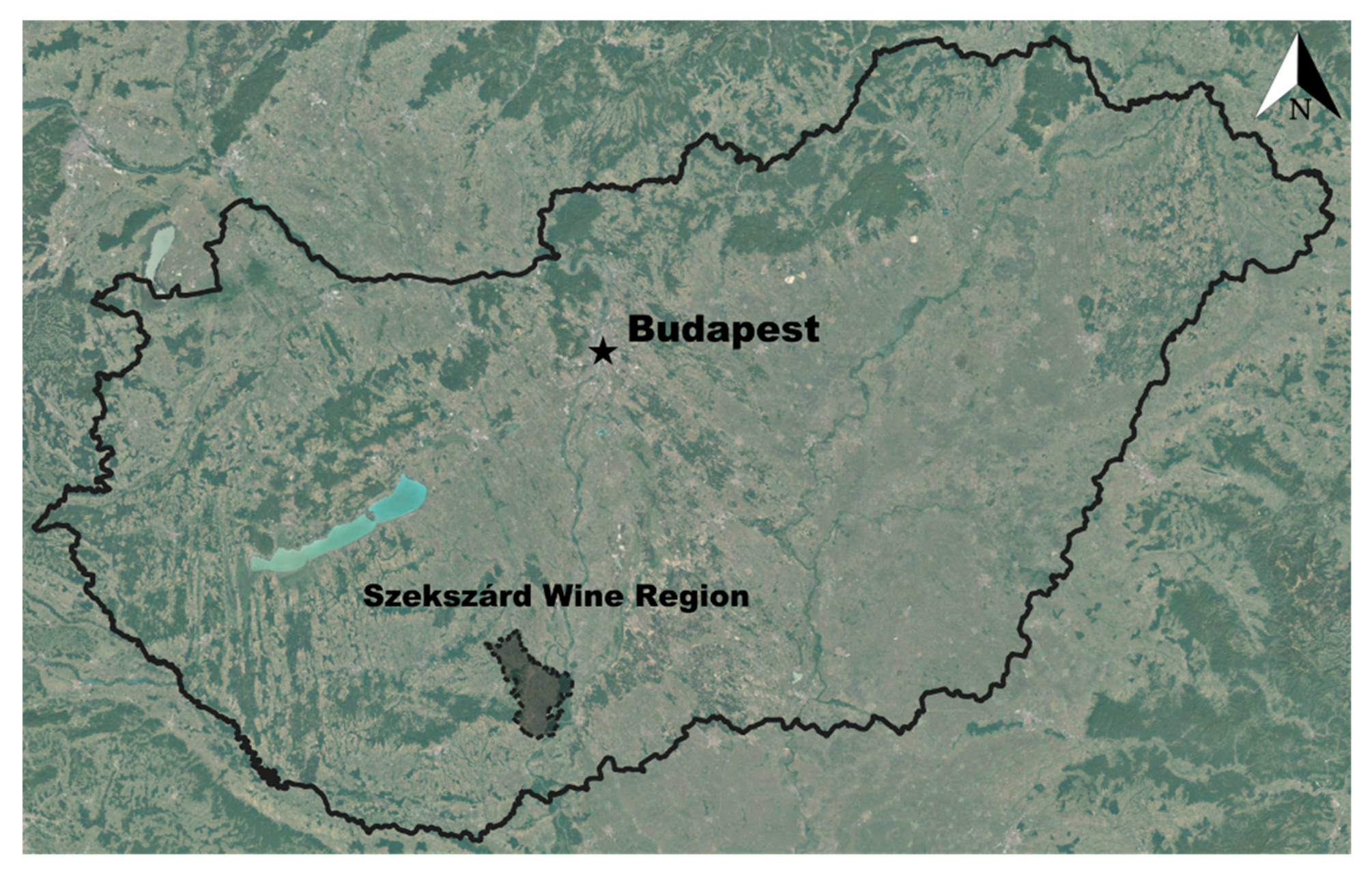
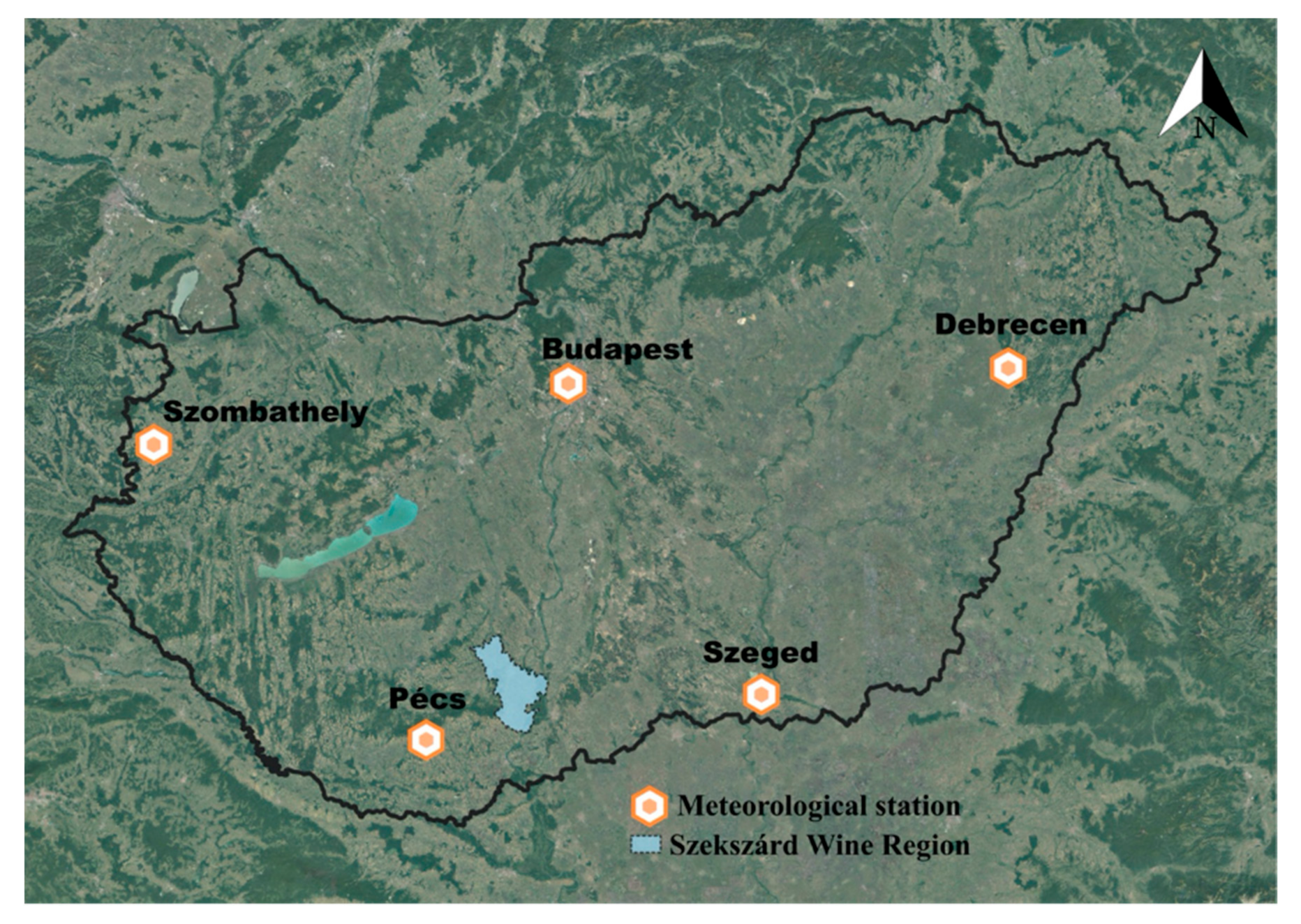
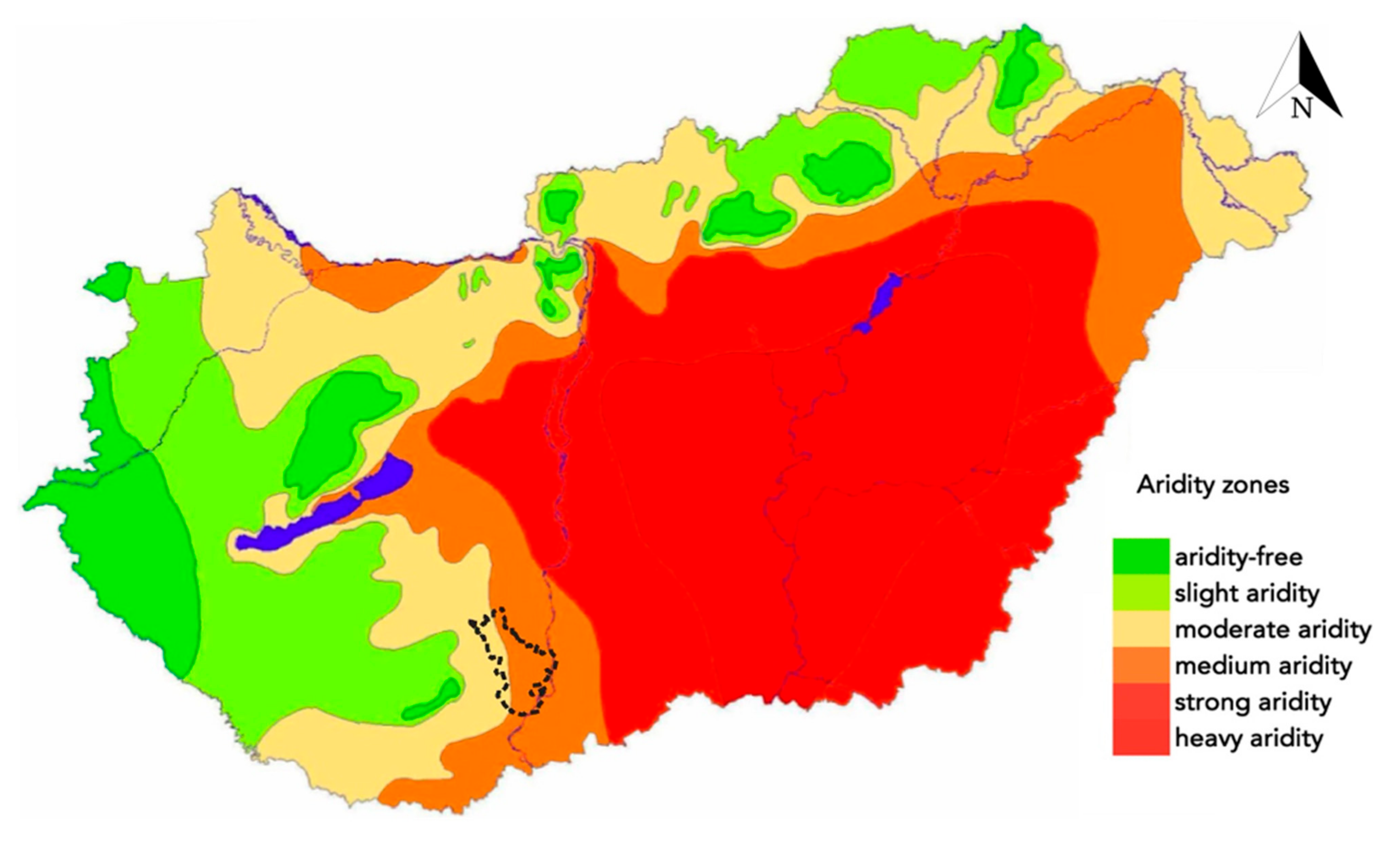
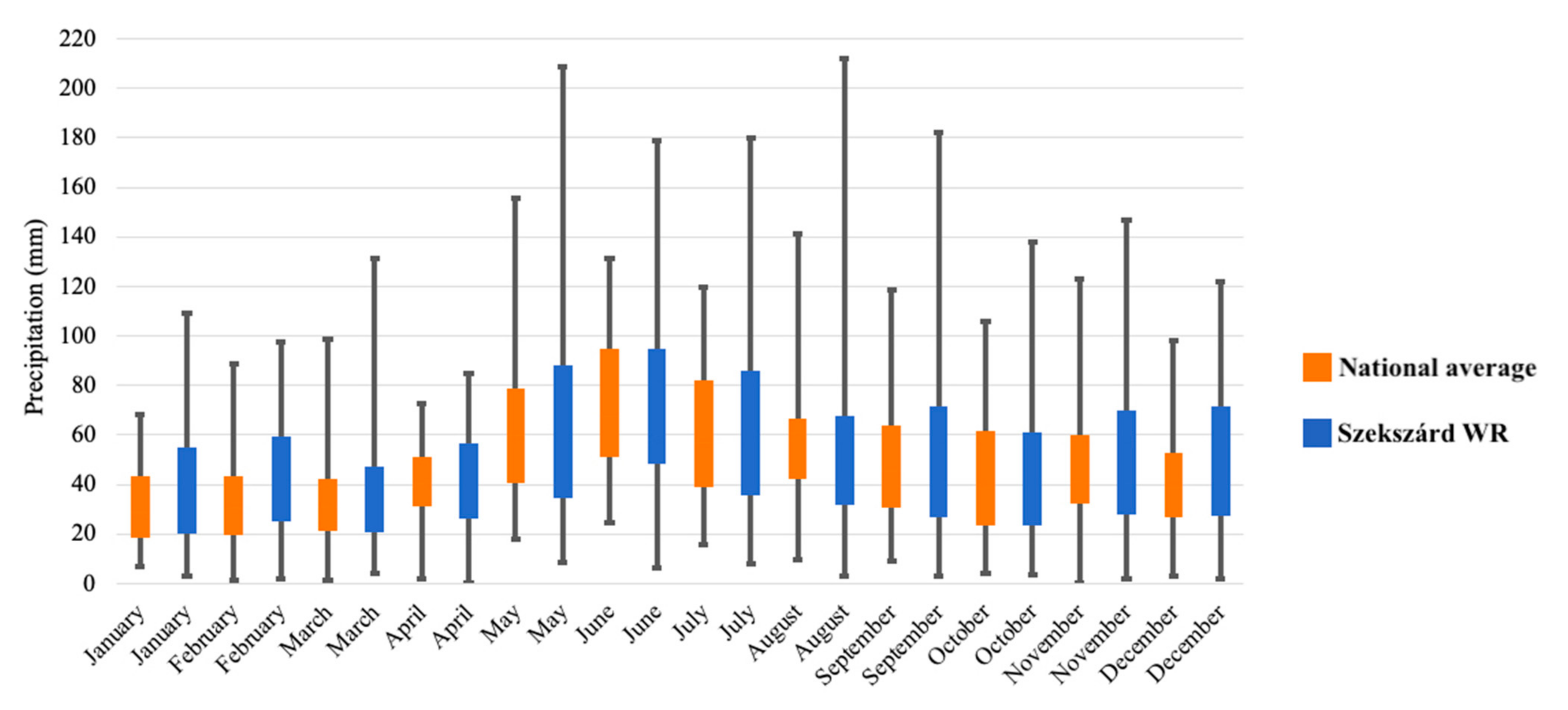
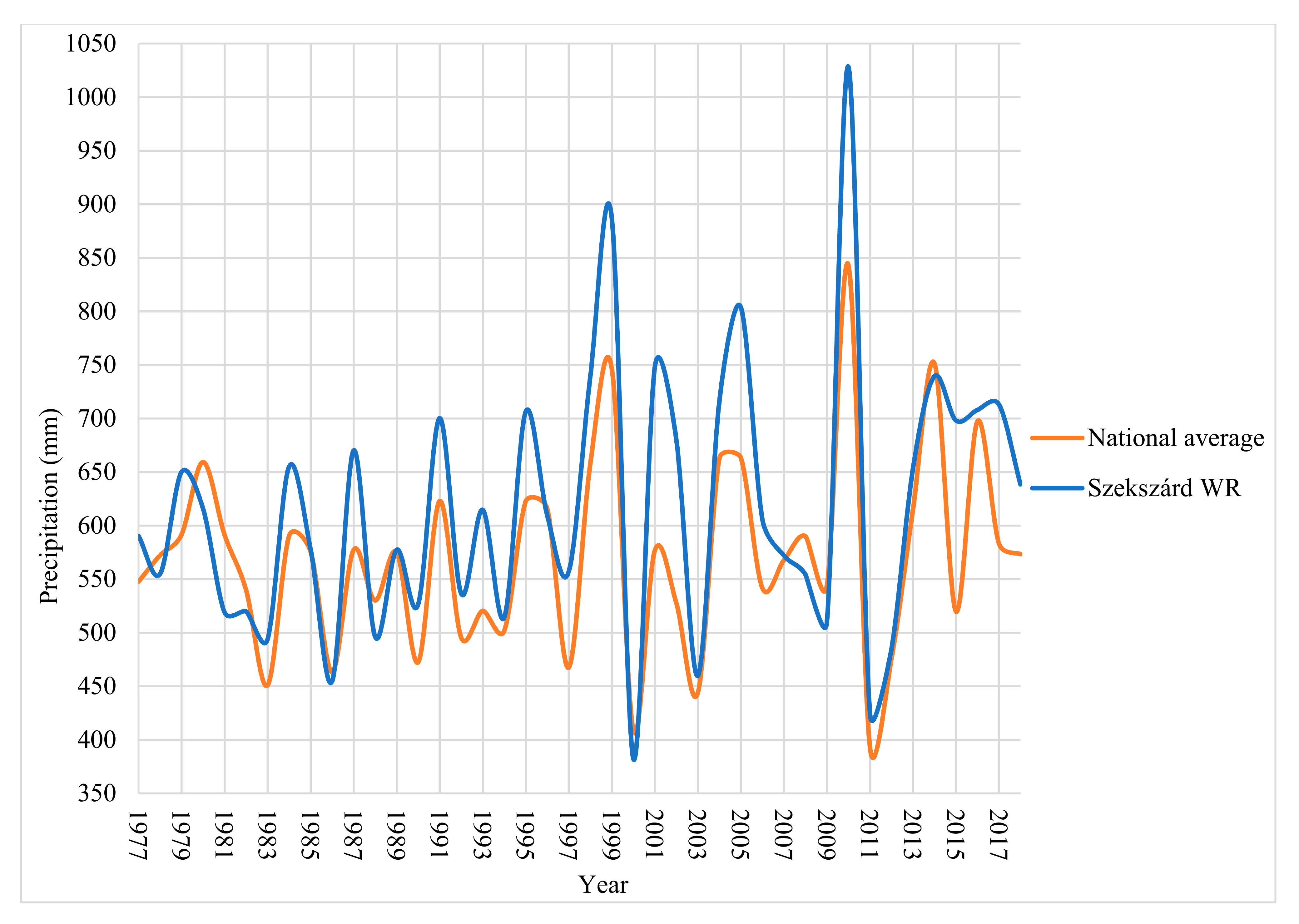

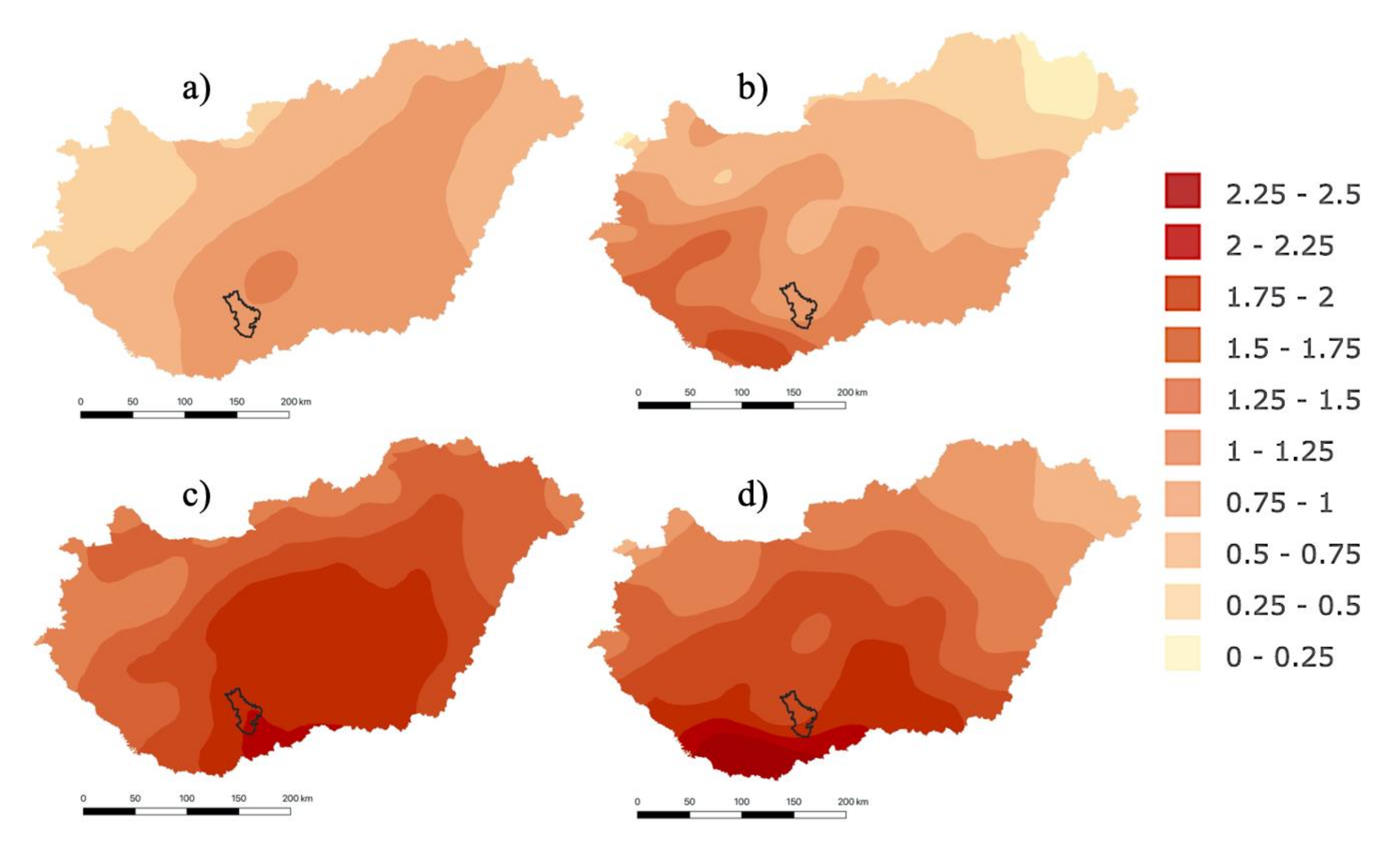
| Source | Spatial Focus |
|---|---|
| [90] | Tuscany, Italy |
| [91] | California, US |
| [42] | Roussillon (France) and McLaren Vale (Australia) |
| [92] | - |
| [93] | Australia |
| [44] | Spain, Portugal |
| [31] | - |
| [94] | New Zealand |
| [95] | - |
| [96] | Portugal |
| [97] | Tuscany, Italy |
| [45] | China |
| [98] | Anjou-Saumur winegrowing sub-region, France |
| [29] | Australia |
| [99] | Emilia Romagna, Italy |
| [30] | Australia |
| [50] | - |
| [100] | Mediterranean countries |
| [5] | - |
| Tolerance to … | Increase of HI | Fungal Diseases on … | |||
|---|---|---|---|---|---|
| Drought | Frost | Leaf | Berries | ||
| Blaufränkisch | |||||
| Merlot | |||||
| Cabernet sauvignon | |||||
| Kadarka | |||||
| Welschriesling | |||||
| Chardonnay | |||||
| Sylvaner | |||||
| Sauvignon blanc | |||||
| Environmental Sustainability Issues | ||||
|---|---|---|---|---|
| Water Consumption | Energy Consumption | Air Pollution | Biodiversity | |
| Use of shading nets/foliar sunscreens | NR | NR | NR | −− |
| Harvesting at night by machine | NR | −− | −− | − |
| Turning on heaters/wind machines | NR | −− | − | − |
| Allowing natural vegetation to grow | ++ | NR | + | ++ |
| Fungicide treatments | NR | NR | −− | −− |
| Site selection | + | − | − | 0 |
| Permanent irrigation | −− | − | NR | ++ |
| Use of well-adapted variety/rootstock | + | + | NR | 0 |
| Canopy management | + | + | NR | 0 |
| Evaporative cooling | −− | −− | − | 0 |
| Drip irrigation | − | − | NR | ++ |
| Non-chemical pest management | NR | NR | 0 | ++ |
| Soil preparation | + | − | 0 | + |
Publisher’s Note: MDPI stays neutral with regard to jurisdictional claims in published maps and institutional affiliations. |
© 2021 by the author. Licensee MDPI, Basel, Switzerland. This article is an open access article distributed under the terms and conditions of the Creative Commons Attribution (CC BY) license (http://creativecommons.org/licenses/by/4.0/).
Share and Cite
Buzási, A. Climate Vulnerability and Adaptation Challenges in Szekszárd Wine Region, Hungary. Climate 2021, 9, 25. https://doi.org/10.3390/cli9020025
Buzási A. Climate Vulnerability and Adaptation Challenges in Szekszárd Wine Region, Hungary. Climate. 2021; 9(2):25. https://doi.org/10.3390/cli9020025
Chicago/Turabian StyleBuzási, Attila. 2021. "Climate Vulnerability and Adaptation Challenges in Szekszárd Wine Region, Hungary" Climate 9, no. 2: 25. https://doi.org/10.3390/cli9020025
APA StyleBuzási, A. (2021). Climate Vulnerability and Adaptation Challenges in Szekszárd Wine Region, Hungary. Climate, 9(2), 25. https://doi.org/10.3390/cli9020025





